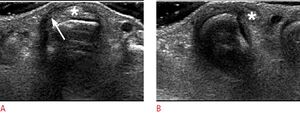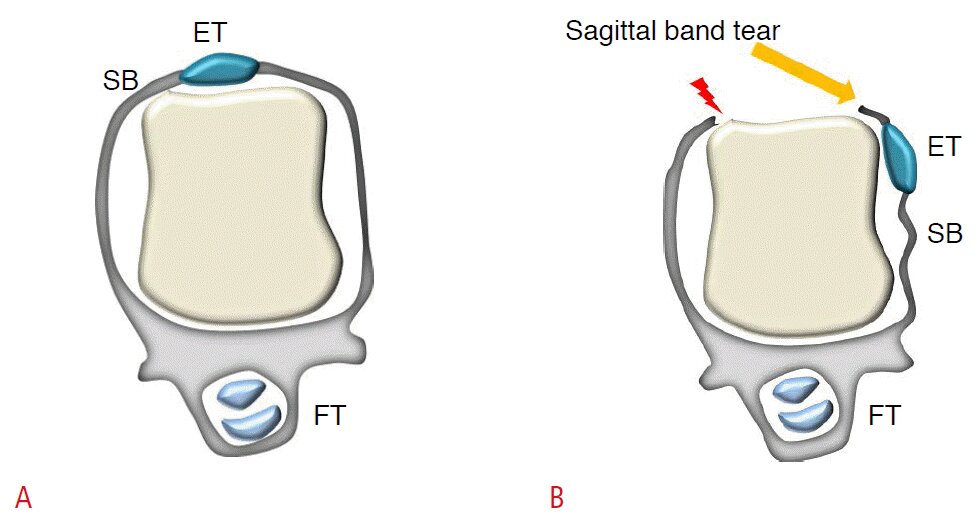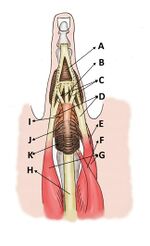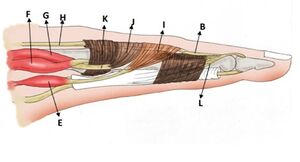Sagittal Band Injuries: Difference between revisions
No edit summary |
|||
| (5 intermediate revisions by the same user not shown) | |||
| Line 1: | Line 1: | ||
{{Partial}} | {{Authors | ||
Sagittal band injuries (also known as Boxer's knuckle, not to be confused with Boxer's fracture) results from acute direct trauma or chronic, repetitive microtrauma, and typically occur in boxers. | |Authors=Jeremy | ||
}} | |||
{{Condition | |||
|quality=Partial | |||
|image=Sagittal band tear.jpg | |||
|caption=A: Intact sagittal band B: Sagittal band tear with subluxation of extensor tendon. ET: extensor tendon; FR: flexor tendon; SB: sagittal band. | |||
|clinicalfeatures=Tendon dislocation during flexion, deviated finger, extensor lag. | |||
|treatment=Surgical repair | |||
}} | |||
'''Sagittal band injuries''' (also known as Boxer's knuckle, not to be confused with Boxer's fracture) results from acute direct trauma or chronic, repetitive microtrauma, and typically occur in boxers. | |||
== Anatomy == | ==Anatomy== | ||
{{multiple image | {{multiple image | ||
| align = right | | align = right | ||
| image1 = Finger extensor mechanism dorsal view.jpg | | image1 = Finger extensor mechanism dorsal view.jpg | ||
| width1 = | | width1 = 150 | ||
| alt1 = | | alt1 = | ||
| image2 = Finger extensor mechanism lateral view.jpg | | image2 = Finger extensor mechanism lateral view.jpg | ||
| width2 = | | width2 = 300 | ||
| alt2 = | | alt2 = | ||
| footer = '''Extensor mechanism of the finger'''. a: triangular ligament; b: central slip; c: slips of long extensor tendon to lateral bands; d: lateral bands; e: lumbrical muscle; f: superficial belly of dorsal interosseous muscle; g: deep belly of dorsal interosseous muscle or palmar interosseous muscle; h: long extensor tendon; i: oblique fibers; j: transverse fibers; '''k: sagittal bands'''; l: oblique retinacular ligament (Landmeer’s ligament)<ref>Ditsios K, Konstantinou P, Pinto I, Karavelis A, Kostretzis L (2017) Extensor Mechanism’s Anatomy at the Metacarpophalangeal Joint. MOJ Orthop Rheumatol 8(4): 00319. DOI: 10.15406/mojor.2017.08.00319</ref> | | footer = '''Extensor mechanism of the finger'''. a: triangular ligament; b: central slip; c: slips of long extensor tendon to lateral bands; d: lateral bands; e: lumbrical muscle; f: superficial belly of dorsal interosseous muscle; g: deep belly of dorsal interosseous muscle or palmar interosseous muscle; h: long extensor tendon; i: oblique fibers; j: transverse fibers; '''k: sagittal bands'''; l: oblique retinacular ligament (Landmeer’s ligament)<ref>Ditsios K, Konstantinou P, Pinto I, Karavelis A, Kostretzis L (2017) Extensor Mechanism’s Anatomy at the Metacarpophalangeal Joint. MOJ Orthop Rheumatol 8(4): 00319. DOI: 10.15406/mojor.2017.08.00319</ref> | ||
}} | }}{{Main|Finger Anatomy}} | ||
The extensor hood stabilises the extensor tendon at the MCPJ, whereas the dorsal extensor apparatus stabilises the PIPJ. | The extensor hood stabilises the extensor tendon at the MCPJ, whereas the dorsal extensor apparatus stabilises the PIPJ. The extensor hood holds the extensor tendons in place and allows the muscles of the finger to effect extension at the PIPJ and DIPJs. The extensor hoot is made up of the sagittal bands, oblique fibres, and transverse fibres. The sagittal bands are the main stabilisers of the extensor hoot and maintain the extensor tendons in the midline of the metacarpal head during flexion and extension of the fingers. The ulnar and radial sagittal bands exert tensile forces in opposite directions during flexion, which keeps the extensor tendon in apposition with the metacarpal bone.<ref name=":0">Lee SA, Kim BH, Kim SJ, Kim JN, Park SY, Choi K. Current status of ultrasonography of the finger. Ultrasonography. 2016 Apr;35(2):110-23. doi: 10.14366/usg.15051. Epub 2015 Nov 24. PMID: 26753604; PMCID: PMC4825212.</ref> | ||
The extensor hood | |||
The extensor | |||
==Pathology== | |||
== Pathology == | |||
Since the sagittal band prevents deviation of the extensor tendon during flexion and bowstringing during MCP joint hyperextension, injury to the sagittal band causes extensor tendon dislocation. | Since the sagittal band prevents deviation of the extensor tendon during flexion and bowstringing during MCP joint hyperextension, injury to the sagittal band causes extensor tendon dislocation. | ||
The most frequent location of this injury is the third finger. The site of the tear may affect whether the extensor tendon is displaced towards the radial or ulnar side. Although the most frequent site of disruption is the radial sagittal band, such that the extensor tendon dislocates in an ulnar direction, radial subluxation can occur with forced valgus injury. Since the second and fifth fingers have two tendons per finger, they may displace in different directions, one to the radial side and the other to the ulnar side.<ref name=":0" /> | The most frequent location of this injury is the third finger. The site of the tear may affect whether the extensor tendon is displaced towards the radial or ulnar side. Although the most frequent site of disruption is the radial sagittal band, such that the extensor tendon dislocates in an ulnar direction, radial subluxation can occur with forced valgus injury. Since the second and fifth fingers have two tendons per finger, they may displace in different directions, one to the radial side and the other to the ulnar side.<ref name=":0" /> | ||
== Clinical Features == | ==Clinical Features== | ||
[[File:Sagittal band tear extensor tendon subluxation.mp4|thumb|right|Extensor tendon dislocation during flexion]]History is often of the patient punching an object with a clenched fist. Less often it can occur in non-traumatic situations such as in Rheumatoid Arthritis. | [[File:Sagittal band tear extensor tendon subluxation.mp4|thumb|right|Extensor tendon dislocation during flexion]]History is often of the patient punching an object with a clenched fist. Less often it can occur in non-traumatic situations such as in Rheumatoid Arthritis. | ||
The sagittal band prevents deviation of the extensor tendon during MCPJ flexion and bowstringing during hyperextension. Therefore extensor tendon dislocation can be observed during flexion.<ref name=":0" /> | On examination the finger may lie in a ulnar or radial deviated position. Acutely there may be swelling. The sagittal band prevents deviation of the extensor tendon during MCPJ flexion and bowstringing during hyperextension. Therefore extensor tendon dislocation can be observed during flexion.<ref name=":0" /> | ||
== Imaging == | ==Imaging== | ||
[[File:Sagittal band tear ultrasound.jpg|thumb|Sagittal band tear in a 43-year-old woman. '''A''': Transverse view of the 3rd MCPJ with finger extended. Abnormal radial sagittal band shown with irregularity and hypoechogenicity (arrow). The extensor tendon (asterix) is positioned normally. | [[File:Sagittal band tear ultrasound.jpg|thumb|Sagittal band tear in a 43-year-old woman. '''A''': Transverse view of the 3rd MCPJ with finger extended. Abnormal radial sagittal band shown with irregularity and hypoechogenicity (arrow). The extensor tendon (asterix) is positioned normally. | ||
| Line 55: | Line 41: | ||
'''Sagittal tears''': In tears ultrasound demonstrates irregular thickening of the abnormal sagittal band with hypoechogenicity. The extensor tendon can appear normal or can become swollen with loss of the fibrillar pattern, suggestive of a partial tear. On dynamic examination, the extensor tendon can be subluxed or dislocated during finger flexion in the transverse plane.<ref name=":0" /> | '''Sagittal tears''': In tears ultrasound demonstrates irregular thickening of the abnormal sagittal band with hypoechogenicity. The extensor tendon can appear normal or can become swollen with loss of the fibrillar pattern, suggestive of a partial tear. On dynamic examination, the extensor tendon can be subluxed or dislocated during finger flexion in the transverse plane.<ref name=":0" /> | ||
== References == | ==Treatment== | ||
The ruptured sagittal band can often be repaired e.g. with mattress sutures. | |||
==References== | |||
{{Article derivation|article-link=https://www.e-ultrasonography.org/journal/view.php?doi=10.14366/usg.15051|article=Current status of ultrasonography of the finger|author=Seun Ah Lee et al|license-link=https://creativecommons.org/licenses/by-nc/3.0/|license=CC-BY-NC}} | {{Article derivation|article-link=https://www.e-ultrasonography.org/journal/view.php?doi=10.14366/usg.15051|article=Current status of ultrasonography of the finger|author=Seun Ah Lee et al|license-link=https://creativecommons.org/licenses/by-nc/3.0/|license=CC-BY-NC}} | ||
[[Category:Hand and Wrist]] | [[Category:Hand and Wrist Conditions]] | ||
<references /> | |||
{{References}} | |||
{{Reliable sources}} | |||
Latest revision as of 10:06, 17 April 2022
Sagittal band injuries (also known as Boxer's knuckle, not to be confused with Boxer's fracture) results from acute direct trauma or chronic, repetitive microtrauma, and typically occur in boxers.
Anatomy
- Main article: Finger Anatomy
The extensor hood stabilises the extensor tendon at the MCPJ, whereas the dorsal extensor apparatus stabilises the PIPJ. The extensor hood holds the extensor tendons in place and allows the muscles of the finger to effect extension at the PIPJ and DIPJs. The extensor hoot is made up of the sagittal bands, oblique fibres, and transverse fibres. The sagittal bands are the main stabilisers of the extensor hoot and maintain the extensor tendons in the midline of the metacarpal head during flexion and extension of the fingers. The ulnar and radial sagittal bands exert tensile forces in opposite directions during flexion, which keeps the extensor tendon in apposition with the metacarpal bone.[2]
Pathology
Since the sagittal band prevents deviation of the extensor tendon during flexion and bowstringing during MCP joint hyperextension, injury to the sagittal band causes extensor tendon dislocation.
The most frequent location of this injury is the third finger. The site of the tear may affect whether the extensor tendon is displaced towards the radial or ulnar side. Although the most frequent site of disruption is the radial sagittal band, such that the extensor tendon dislocates in an ulnar direction, radial subluxation can occur with forced valgus injury. Since the second and fifth fingers have two tendons per finger, they may displace in different directions, one to the radial side and the other to the ulnar side.[2]
Clinical Features
History is often of the patient punching an object with a clenched fist. Less often it can occur in non-traumatic situations such as in Rheumatoid Arthritis.
On examination the finger may lie in a ulnar or radial deviated position. Acutely there may be swelling. The sagittal band prevents deviation of the extensor tendon during MCPJ flexion and bowstringing during hyperextension. Therefore extensor tendon dislocation can be observed during flexion.[2]
Imaging

Normal: US depicts the normal sagittal bands as thin hyperechoic bands that join the extensor tendons at the MCP joint level. The central slip can be seen up to its insertion into the middle phalangeal base in the dorsal aspect. More distally, US depicts the lateral slips as thin, flattened, hyperechoic structures close to the phalangeal cortex. Since it is difficult to accurately assess the dorsal aspect of the interphalangeal (IP) joints in the transverse plane, US of joints is mainly performed in the longitudinal plane. In longitudinal US, the central slip is seen as a hyperechoic structure running through the subcutaneous soft tissue over the echogenic bony cortex, whereas the two lateral slips are hardly visible.
Sagittal tears: In tears ultrasound demonstrates irregular thickening of the abnormal sagittal band with hypoechogenicity. The extensor tendon can appear normal or can become swollen with loss of the fibrillar pattern, suggestive of a partial tear. On dynamic examination, the extensor tendon can be subluxed or dislocated during finger flexion in the transverse plane.[2]
Treatment
The ruptured sagittal band can often be repaired e.g. with mattress sutures.
References
Part or all of this article or section is derived from Current status of ultrasonography of the finger by Seun Ah Lee et al, used under CC-BY-NC
- ↑ Ditsios K, Konstantinou P, Pinto I, Karavelis A, Kostretzis L (2017) Extensor Mechanism’s Anatomy at the Metacarpophalangeal Joint. MOJ Orthop Rheumatol 8(4): 00319. DOI: 10.15406/mojor.2017.08.00319
- ↑ 2.0 2.1 2.2 2.3 Lee SA, Kim BH, Kim SJ, Kim JN, Park SY, Choi K. Current status of ultrasonography of the finger. Ultrasonography. 2016 Apr;35(2):110-23. doi: 10.14366/usg.15051. Epub 2015 Nov 24. PMID: 26753604; PMCID: PMC4825212.
Literature Review
- Reviews from the last 7 years: review articles, free review articles, systematic reviews, meta-analyses, NCBI Bookshelf
- Articles from all years: PubMed search, Google Scholar search.
- TRIP Database: clinical publications about evidence-based medicine.
- Other Wikis: Radiopaedia, Wikipedia Search, Wikipedia I Feel Lucky, Orthobullets,





